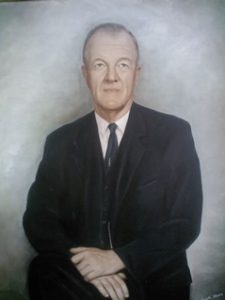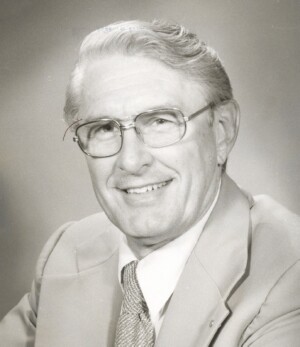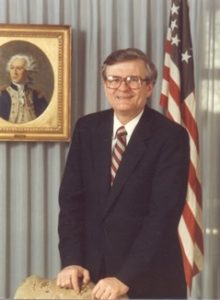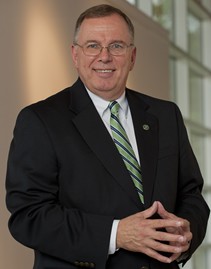Past Presidents of Methodist University
Lucius Stacy Weaver (1957-1973)
 Lucius Stacy Weaver was elected the first president of Methodist University (then Methodist College) in June 1957. At the time of his election, he was serving as superintendent of the Durham (N.C.) city school system.
Lucius Stacy Weaver was elected the first president of Methodist University (then Methodist College) in June 1957. At the time of his election, he was serving as superintendent of the Durham (N.C.) city school system.
Dr. Weaver is regarded as one of Methodist’s “founding fathers,” along with Terry Sanford, first chairman of the Board of Trustees; the Reverend Paul Neff Garber, bishop of the North Carolina Conference of the Methodist Church; and Franklin S. Clark, Jr., president of the Fayetteville College Foundation. During his first three years as president, Dr. Weaver worked from an office in downtown Fayetteville.
A native of Lenoir, N.C., Stacy Weaver was one of five children of Dr. Charles C. and Florence Stacy Weaver. His father was a Methodist minister who served as president of Davenport College (a precursor of Brevard College) and Emory and Henry College. Stacey Weaver held an A.B. degree from Duke University, an M.A. from Columbia University, and honorary doctorates from High Point College, Duke University, and Methodist College (now University).
Stacy Weaver became a leader in public education in his native state, serving as a school principal in Union County and Jonesville; a professor of Latin and Greek, a coach, and president at Rutherford College; president of Mountain Park Junior College; and superintendent of the Statesville and Durham city schools. He was a member of Who’s Who in American Education, Who’s Who in the South, and Who’s Who in Methodism. Three Tar Heel governors appointed him to state commissions on public school law, public school finance, and public television.
Upon accepting the presidency of Methodist College, Dr. Weaver pledged the school would be “Christian in concept and dedicated to academic excellence.” When Dr. Weaver arrived, Dr. Weaver raised the funds needed to build Methodist, oversaw construction of the campus, and recruited the original staff, faculty, and student body. Methodist opened in the fall of 1960 with 128 students; enrollment peaked during Weaver’s tenure at 1,100 students in 1967.
In 1964, the Weaver family established the Lucius Stacy Weaver Award, which is given each spring to the spring graduate voted by the faculty as the student who best exemplifies academic excellence, spiritual development, leadership, and service. In 1965, the trustees named the first women’s residence hall Weaver Hall in honor of Dr. Weaver.
When Dr. Weaver retired in 1973, he delivered a commencement address entitled “This I Believe” to spring graduates. In his address, he cited three core principles in which he believed: “1) the divinity of human personality, 2) the improvability of human personality, 3) that Christian education is the best means yet devised for the development of human personality.”
Stacy Weaver and his wife Elizabeth retired first to Lake Junaluska, N.C., and later to Lakeland, Fla. Dr. Weaver died March 25, 1997, at the age of 92. Elizabeth Weaver died July 8, 2002 at the age of 95. The Weavers are buried at Lafayette Memorial Park in north Fayetteville.
Richard W. Pearce (1973-1983)
 Richard W. Pearce, the second president of Methodist University (then Methodist College), served from 1973-83. When he was elected president, he was vice president and academic dean at Florida Southern College in Lakeland; he was 49 years of age.
Richard W. Pearce, the second president of Methodist University (then Methodist College), served from 1973-83. When he was elected president, he was vice president and academic dean at Florida Southern College in Lakeland; he was 49 years of age.
Born in Glen Ellyn, Illinois, Richard Pearce moved with his family to Hendersonville, N.C., when he was a child. After graduating from Hendersonville High, he took machinist’s training at Newport News (Va.) Apprentice School and joined the U.S. Navy Reserve, attending radio and radar school in the Washington, D.C. area. After completing his Navy service, he attended The University of North Carolina for two years before enrolling at Stetson University. He held J.D., M.A. and B.A. degrees from Stetson University where he taught business and chaired the Business Department. Prior to joining the faculty at Stetson, Pearce was in private law practice in Pierson, Fla.
A Methodist layman with deep roots in The United Methodist Church, Dr. Pearce promised to reverse a three-year decline in enrollment by emphasizing student aid, a quality educational program, and the College’s religious affiliation. He said Methodist could not be all things to all people and should market itself as a residential, undergraduate, church-involved liberal arts college designed primarily for 17-22-year-olds and offering “choice within limits” in both its academic and student life programs. He said the college would not tolerate use and possession of alcohol or improper or illegal use of drugs and would not have open dorms.
When Dr. Pearce arrived in 1973, enrollment stood at 617 students, and the four residence halls had an occupancy rate of 45 percent; capital indebtedness totaled $4.2 million. During much of his tenure, low enrollment forced Dr. Pearce to cut faculty and staff positions, defer maintenance, borrow money to meet current operating expenses, and suspend payments on federal loans used to build four residence halls. In 1975, he persuaded the College trustees to adopt a plan to raise $16 million over the next 15 years, but the plan was never implemented. In 1982, he urged the trustees to authorize the purchase or lease of College land to generate funds for the College endowment.
In an effort to boost enrollment, Dr. Pearce added new majors, associate (two-year) degrees, an evening program, and an Army ROTC program. He also eliminated $300,000 in revolving debt. Enrollment grew to 950 students by the fall of 1980. By the spring of 1982, the College endowment had more than doubled from a 1970 figure of $556,000, reaching $1.2 million. In the late 1970s and early 1980s, the Methodist College Foundation surpassed its annual Loyalty Fund goals, raising as much as $275,000 from Fayetteville residents to support College operations. In April, 1983, the Reverend Sam McMillan told College trustees that the Board of Higher Education and Campus Ministry of The North Carolina Conference of The United Methodist Church had voted to ask the conference to budget $157,742 to help the College repay HUD and HEW construction loans, which would increase church support of Methodist College from $525,000 to $775,000 annually.
In a January 27, 1983, convocation address, Dr. Pearce expressed sadness over “the loss of a substantial number of students for academic reasons” at the end of the fall 1982 semester. He reported that the College had enrolled 580 full-time students and 140-160 evening students for the spring 1983 semester. In April, 1983, after a Durham-based marketing, fund-raising, and public relations consulting firm submitted a detailed capital fund drive feasibility study (for raising $3 million) to the trustees’ Executive Committee, Dr. Pearce resigned as president and announced that he and Mrs. Pearce would return to Florida.
In May 1991, Methodist awarded Dr. Pearce an honorary Doctor of Humanities degree. In the fall of 1998, Methodist’s Board of Trustees voted to rename East Hall (a co-ed residence hall) Pearce Hall, in honor of Richard Pearce and his late wife Neva. Dr. Pearce died peacefully at his home in Deland, Fla. on Sept. 15, 2016.
Highlights of Dr. Pearce’s Presidency
- Establishment of a President’s List to recognize students with a 4.0 (A) average at the end of each semester.
- Appointment of the Rev. Bill Lowdermilk to the new position of assistant to the president.
- Inauguration of Greek letter societies, fraternities and sororities, in 1974.
- Addition of majors in art education, physical education, and social work; associate (two-year) degrees; an evening program; an Army ROTC program; full-time chaplain; full-time alumni director; full-time director of development; an East-West Foundation Summer Program for Japanese students; a hand bell choir.
- Completion of Shelley Baseball Field; a track; tennis courts; and the President’s Home on campus.
- Awarding of honorary degrees and college medallions, along with Greatest Gift Scholarships allowing each Methodist alumni and College trustee to award a one-fourth tuition scholarship to a deserving person that he or she had recruited to attend Methodist.
- A campus-wide energy conservation program.
- A new statement of purpose for the College in 1978.
- Awarding Methodist College degrees to his wife Neva and his mother Alice; crowning his 79-year-old mother homecoming queen in 1977.
M. Elton Hendricks (1983-2010)
 M. Elton Hendricks became the third president of Methodist University (then Methodist College) in 1983. When he retired 27 years later, he had served longer that any of the 36 presidents then working at independent colleges and universities in North Carolina. An ordained elder in the United Methodist Church, Dr. Hendricks has served as pastor of Lillington (N.C.) United Methodist Church for the last few years.
M. Elton Hendricks became the third president of Methodist University (then Methodist College) in 1983. When he retired 27 years later, he had served longer that any of the 36 presidents then working at independent colleges and universities in North Carolina. An ordained elder in the United Methodist Church, Dr. Hendricks has served as pastor of Lillington (N.C.) United Methodist Church for the last few years.
Hendricks holds a Ph.D. in physics from the University of South Carolina, a Master of Divinity from Duke University, and a bachelor’s, Phi Beta Kappa, in history from Wofford College. He is also a graduate of Harvard University’s Institute for Educational Management. He has published numerous articles on Methodism and physics.
Originally from Savannah, Ga., Hendricks started his career in the U.S. Navy as a naval flight officer. After serving his country, he served a local congregation as a Methodist minister. He began his teaching career at Eisenhower College teaching physics, philosophy, and religion.
He taught at his alma mater, Wofford College (S.C.) and served as both the school’s residence hall education program director and as director of Admissions. He went on to become the academic dean of Randolph-Macon College in Virginia. After serving briefly as Randolph-Macon’s acting president, Hendricks came to Methodist University as president in September 1983.
He served as a member of the North Carolina Association of Independent Colleges and Universities Executive Committee, the Fayetteville Area Chamber of Commerce Board of Directors, the National Association of Schools and Colleges of the United Methodist Church, the Southern Association of Colleges and Schools, the Fayetteville Economic Development Corporation, the Arts Council of Fayetteville/Cumberland County, and as president of Cape Fear Industries. Hendricks also spent several summers with a mission team as a construction worker in rural Bolivia.
He and his wife, Jerry, have three grown children and four grandchildren. They reside in the Fairfield Farms area about a mile north of Methodist University.
Highlights of Dr. Hendricks’ Presidency
- Enrollment more than doubled since 1983, and the number of international students increased six-fold. At the end of 2010, the number of MU graduates reached 9,904.
- Endowment increased to $15 million.
- Three strategic plans were developed and implemented since 1989.
- Three capital campaigns were successfully completed, netting a total of $27.4 million.
- College developed a full-certified police (public safety) department to provide around-the-clock security for the campus.
- Methodist sold tax-free revenue bonds on three separate occasions, raising $30 million and using the proceeds to restructure existing debt and finance needed campus improvements.
- Eleven new buildings, a soccer complex, a challenge course, an office park, and a golf course were built. Major renovations were completed on residence halls, the science building and the cafeteria.
- Extensive landscaping, Phases I and II of campus irrigation, and a greenhouse were completed.
- Methodist added twenty-five degree programs (including business administration majors with concentrations in golf, tennis and resort management) and three master’s degree programs, then secured national accreditation for five of these programs. In addition, the school added online courses and established the Reeves School of Business, the Center for Entrepreneurship, and the Lura S. Tally Center for Leadership Development.
- Methodist required students to sign an academic Honor Code (with specific penalties for cheating and plagiarism) and created an Honor Board to handle major infractions.
- Faculty sabbaticals were implemented, and hourly employees were welcomed into the College’s benefits program.
- Methodist offered its first “full-tuition” academic scholarships to outstanding students.
- Rooms in all residence halls were wired for telephone, cable TV, and Internet service.
- A campus computing network, Computer-Assisted Composition Laboratory, and Writing Center were established.
- Methodist doubled the size of its admissions, development, and public relations staffs, increased its advertising budget by a factor of 56, launched a quarterly newsmagazine and a website, developed annual marketing plans, and hired graphic design professionals to create new and colorful student recruitment literature, websites, and brochures promoting academic and athletic programs.
- Women’s soccer, football, and women’s lacrosse were added to the roster of NCAA Division III teams. Methodist joined a new athletic conference, USA South.
- Methodist’s men’s and women’s golf teams won 32 national championships (nine for the men and 23 for the women).
- The first history of Methodist University was commissioned in 2002 and published in 2009. In addition, the president funded a University Archives Room and a full-time university archivist for Davis Memorial Library. Two college history videos were produced.
- Methodist College became Methodist University in November 2006, fifty years after it was chartered as a “senior, coeducational college of liberal arts and sciences.”
Ben E. Hancock, Jr. (2011-2018)
 Ben Hancock was President of Methodist University from March 2011 until his May 2018 retirement. He led the institution through a five-year Strategic Plan during a period of unprecedented growth that includes a record enrollment of over 2,400 students and record student residential population of over 1,100.
Ben Hancock was President of Methodist University from March 2011 until his May 2018 retirement. He led the institution through a five-year Strategic Plan during a period of unprecedented growth that includes a record enrollment of over 2,400 students and record student residential population of over 1,100.
Prior to assuming the presidency at Methodist University, Dr. Hancock served as vice president for University Advancement at Ball State University from 2006 to 2011. Prior to this appointment, Hancock was vice president for Institutional Advancement at Albion College from 1989 to 2006.
From 1984 through 1989, he served as Executive Director of the Boise State University Foundation in Boise, Idaho. In this position he served as chief development officer and provided the staff leadership for the Foundation’s Board of Directors and directed all development activities including special fund-raising campaigns, major gifts, corporate and foundation relations, and annual giving.
He received his Bachelor of Arts in Russian Studies and his Masters in Education from James Madison University in Virginia. He completed his Ph.D. at the University of Virginia in comparative and international education. His dissertation was entitled, “The Role of Philanthropy in the Development of British Higher Education during the Victorian Period (1851-1919).” He continues his research and professional involvement in philanthropy and civic engagement.
Dr. Hancock was very involved professionally during his tenure, serving as president of the National Association of Schools, Colleges, and Universities of the Methodist Church (NASCUMC). He was on the Executive Committee for the North Carolina Independent Colleges and Universities (NCICU) and the North Carolina Campus Compact, and served on the Presidents Council for the USA South Athletic Conference.
His community involvement has included serving as a Presbyterian Church elder, scout leader, Chamber of Commerce board member, Rotary Club member, Community Foundation board member, United Way campaign chair and board member, and economic development board member. Dr. Hancock received the Ronald E. Carrier Distinguished Alumni Achievement Award from JMU in 2011 and the Bravo! Award from Chesterfield Public Education Foundation (Va.) in 2012 as an outstanding alumnus of the school system.
He and his wife Debbie (a teacher of exceptional children) have five children: Jessie, Sarah, Ben, Matthew, and Andrew.
Highlights of Dr. Hancock’s Presidency
- The MU Journey was established, linking the Centers for Community Engagement, Research and Creativity, Global Education, and the Lura S. Tally Center for Leadership Development.
- Methodist University concluded a successful capital campaign, “Building Excellence: The Campaign for MU,” which raised over $41 million, surpassing its $35 million goal.
- Several new buildings were added across campus: A Campus Services Building, housing Police & Public Safety, Monarch Press, and Computer Services; the Thomas R. McLean Health Sciences Building, housing the Athletic Training, Kinesiology, Health Care Administration, Physical Therapy, and Occupational Therapy departments; the Professional Nursing Studies Building, housing the Nursing Program and the Simulation Hospital; the Gene Clayton Tennis Center, housing the PTM and Tennis coaching staff; the Armstrong Baseball Field House; a Football Field House expansion; North Hall; Village housing expansion; and the in-progress construction of the Price Softball Field House and the Matthews Ministry Center (with the corresponding renovation of the Reeves Fine Arts Building, Huff Concert Hall, and the Union-Zukowski Lobby & Gallery).
- Methodist University’s first two doctoral programs debuted, the first in Physical Therapy (DPT) and the second in Occupational Therapy (OTD), and a new Master of Education degree was added, with concentrations in Literacy, Special Education, Physical Education, and Coaching & Athletic Administration. The Professional MBA program was approved to become MU’s first fully online degree program beginning in the Fall 2018 semester.
- The School of Health Sciences was established, and new undergraduate majors in Graphic Design, Engineering, Applied Forensic Science, Entrepreneurship, Sport Management, and Digital Forensics & Cybersecurity were added to the University curriculum.
- The Campus Master Plan launched in 2012, leading to new landscaping and improvements to the entrance to the University and renovations of the Davis Memorial Library and Trustees Building, to include a state-of-the art Mass Communications lab.
- The Center for Student Success was created to house testing, tutoring, advising, and retention programs.
- A focus on experiential learning led to the MU Advantage, which provides opportunities for an internship or related experience for every Methodist student.
- Methodist University completed successfully a five-year Title III grant, which led to campus-wide improvements in instructional and administrative technology, such as the Jenzabar student information system (known as the myMU Portal).
- A new series of global and nationwide events for alumni was established, entitled “MU on the Move.”
- Grants were established to provide financial aid for students conducting and presenting research or for studying abroad.
- The Monarch Review, the Methodist University journal for undergraduate research, was established. The Monarch Review accepts peer- and professor-reviewed student research papers and juried artwork and musical performances.
- The Presidential Lecture Series was established to bring to campus renowned experts in their fields, such as CNN medical correspondent Dr. Sanjay Gupta, Team of Rivals author Doris Kearns Goodwin, and Major League Baseball Hall of Famer Cal Ripken, Jr.